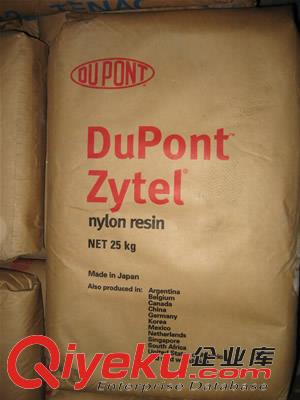- 产品特性
特点:Zytel® 74G33J NC010 is a 33% glass reinforced nylon 66 and nylon 6 comelt resin.
PA6 74G33J NC010 含33%玻璃纤维增强
Zytel® PA6 74G33J NC010 | (PA66+PA6)-GF33 NYLON RESIN
Characteristics
Regional Availability
Asia Pacific
Product Text
Common features of Zytel® nylon resin include mechanical and physical properties such as high mechanical strength, excellent balance of stiffness and toughness, good high temperature performance, good electrical and flammability properties, good abrasion and chemical resistance. In addition, Zytel® nylon resins are available in different modified and reinforced grades to create a wide range of products with tailored properties for specific processes and end-uses. Zytel® nylon resin, including most flame retardant grades, offer the ability to be coloured.
The good melt stability of Zytel® nylon resin normally enables the recycling of properly handled production waste. If recycling is not possible, DuPont recommends, as the preferred option, incineration with energy recovery (-31kJ/g of base polymer) in appropriately equipped installations. For disposal, local regulations have to be observed.
Zytel® nylon resin typically is used in demanding applications in the automotive, furniture, domestic appliances, sporting goods and construction industry.
Zytel® 74G33J NC010 is a 33% glass reinforced nylon 66 and nylon 6 comelt resin.
PROPERTIES
|
Rheological properties |
dry / cond |
Unit |
Test Standard |
|
|
Rheo |
Moulding shrinkage, parallel |
0.2 / * |
% |
ISO 294-4, 2577 |
|
Moulding shrinkage, normal |
0.9 / * |
% |
ISO 294-4, 2577 |
|
|
Mechanical properties |
dry / cond |
Unit |
Test Standard |
|
|
Mech |
Tensile Modulus |
10000 / 6000 |
Mpa |
ISO 527-1/-2 |
|
Charpy impact strength |
ISO 179/1eU |
|||
|
23℃ |
85 / 100 |
kj/㎡ |
||
|
-30℃ |
70 / 65 |
kj/㎡ |
||
|
Charpy notched impact strength |
ISO 179/1eA |
|||
|
23℃ |
12 / 18 |
kj/㎡ |
||
|
-30℃ |
10 / 10 |
kj/㎡ |
||
Chem
Chemical Media Resistance
Acids
√ Acetic Acid (5% by mass) (23℃)
√ Citric Acid solution (10% by mass) (23℃)
√ Lactic Acid (10% by mass) (23℃)
× Hydrochloric Acid (36% by mass) (23℃)
× Nitric Acid (40% by mass) (23℃)
× Sulfuric Acid (38% by mass) (23℃)
× Sulfuric Acid (5% by mass) (23℃)
× Chromic Acid solution (40% by mass) (23℃)
Bases
× Sodium Hydroxide solution (35% by mass) (23℃)
√ Sodium Hydroxide solution (1% by mass) (23℃)
√ Ammonium Hydroxide solution (10% by mass) (23℃)
Alcohols
√ Isopropyl alcohol (23℃)
√ Methanol (23℃)
√ Ethanol (23℃)
Hydrocarbons
√ n-Hexane (23℃)
√ Toluene (23℃)
√ iso-Octane (23℃)
Ketones
√ Acetone (23℃)
Ethers
√ Diethyl ether (23℃)
Mineral oils
√ SAE 10W40 multigrade motor oil (23℃)
√ SAE 10W40 multigrade motor oil (130℃)
√ SAE 80/90 hypoid-gear oil (130℃)
√ Insulating Oil (23℃)
Standard Fuels
√ ISO 1817 Liquid 1 (60℃)
√ ISO 1817 Liquid 2 (60℃)
√ ISO 1817 Liquid 3 (60℃)
√ ISO 1817 Liquid 4 (60℃)
√ Standard fuel without alcohol (pref. ISO 1817 Liquid C) (23℃)
√ Standard fuel with alcohol (pref. ISO 1817 Liquid 4) (23℃)
√ Diesel fuel (pref. ISO 1817 Liquid F) (23℃)
√ Diesel fuel (pref. ISO 1817 Liquid F) (90℃)
√ Diesel fuel (pref. ISO 1817 Liquid F) (>90℃)
Salt solutions
√ Sodium Chloride solution (10% by mass) (23℃)
× Sodium Hypochlorite solution (10% by mass) (23℃)
√ Sodium Carbonate solution (20% by mass) (23℃)
√ Sodium Carbonate solution (2% by mass) (23℃)
× Zinc Chloride solution (50% by mass) (23℃)
Other
√ Ethyl Acetate (23℃)
× Hydrogen peroxide (23℃)
√ DOT No. 4 Brake fluid (130℃)
√ Ethylene Glycol (50% by mass) in water (108℃)
√ 1% nonylphenoxy-polyethyleneoxy ethanol in water (23℃)
√ 50% Oleic acid + 50% Olive Oil (23℃)
√ Water (23℃)
× Water (90℃)
× Phenol solution (5% by mass) (23℃)
Symbols used:
√ possibly resistant
Defined as: Supplier has sufficient indication that contact with chemical can be potentially accepted under the intended use conditions and expected service life. Criteria for assessment have to be indicated (e.g. surface aspect, volume change, property change).
× not recommended - see explanation
Defined as: Not recommended for general use. However, short-term exposure under certain restricted conditions could be acceptable (e.g. fast cleaning with thorough rinsing, spills, wiping, vapor exposure).
